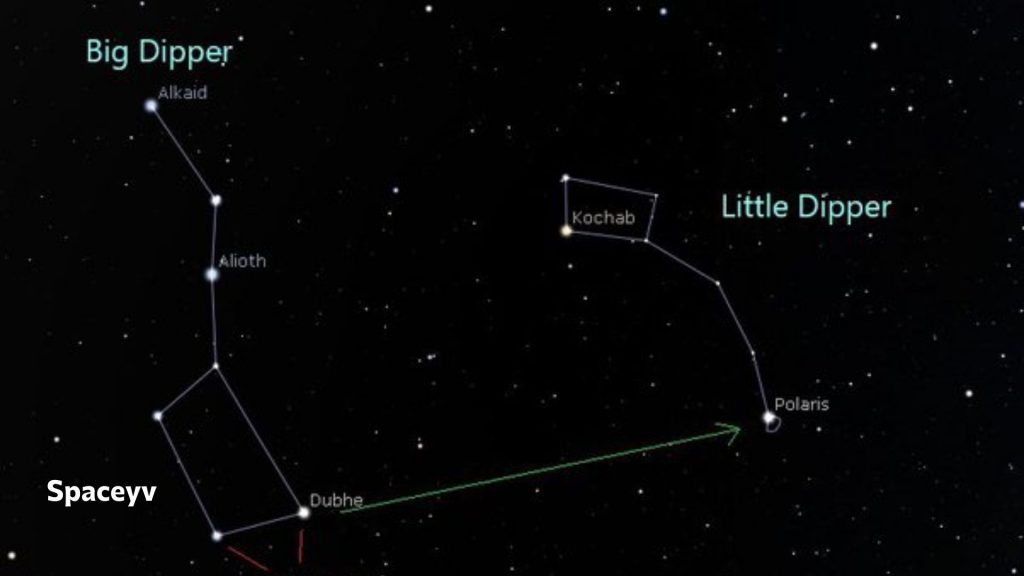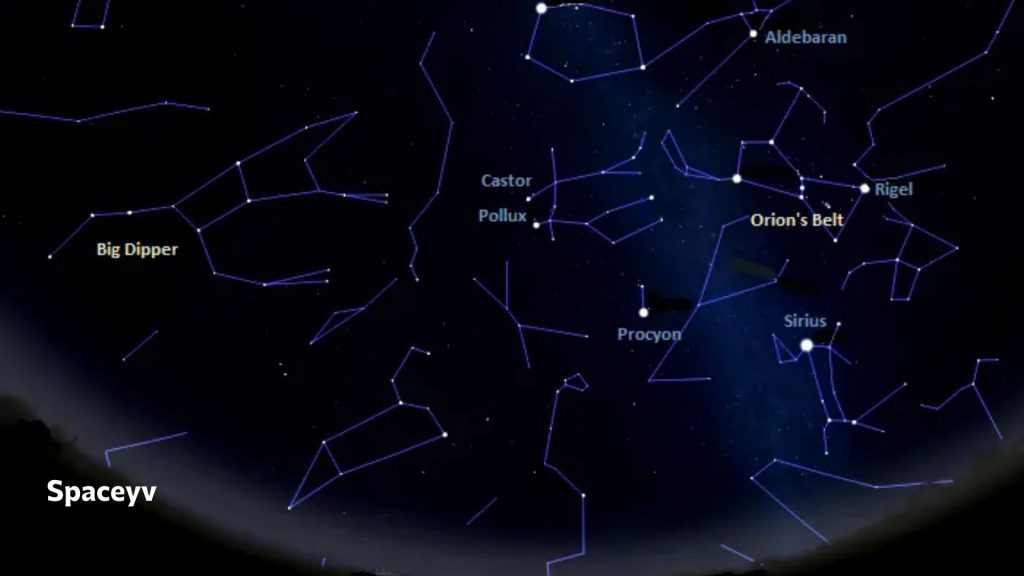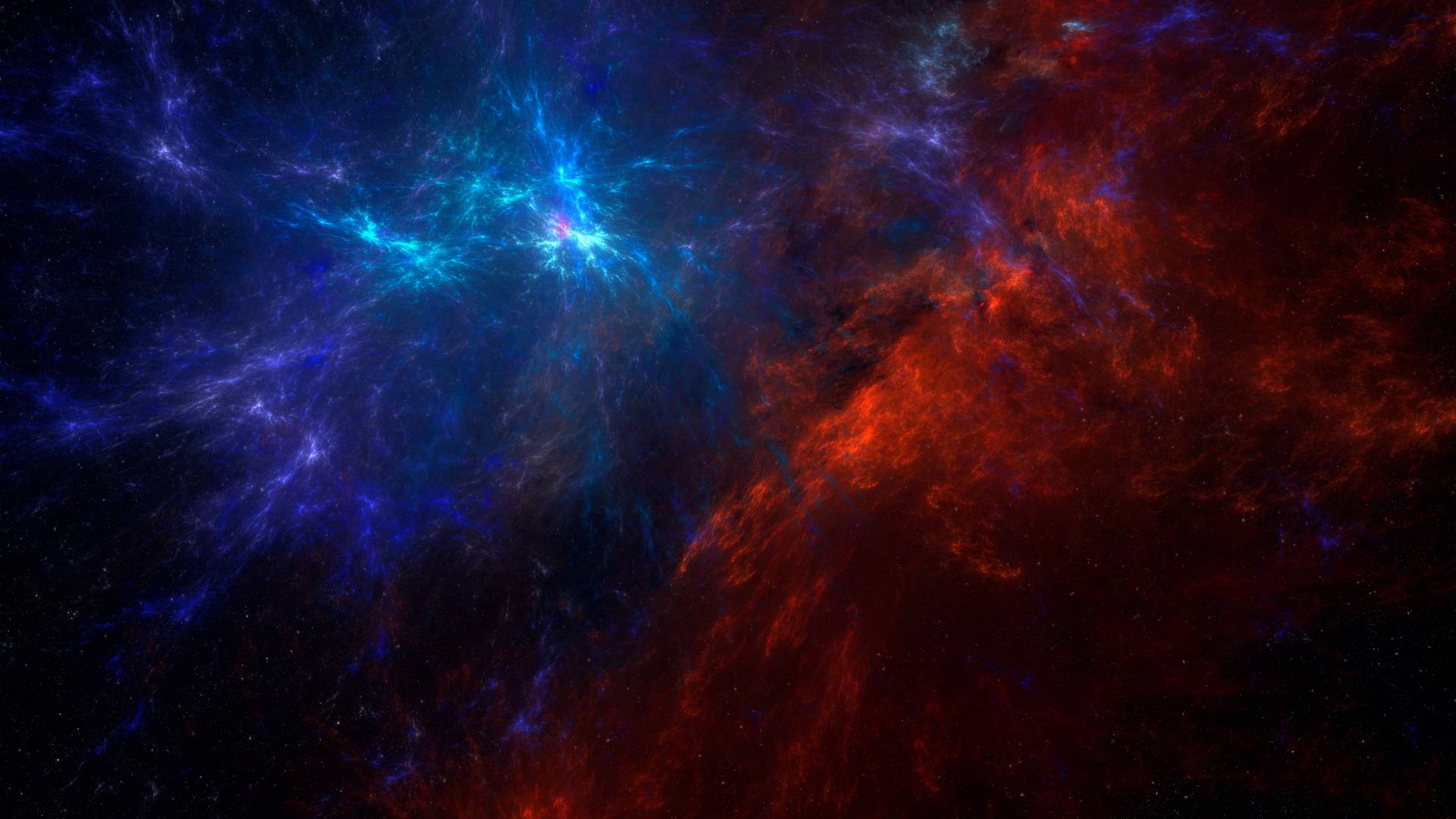In the vast expanse of the night sky, we focused on Orion’s belt vs big dipper? certain constellations stand out as iconic symbols of celestial beauty and wonder. Among these, Orion’s Belt and the Big Dipper hold prominent places in the cultural and astronomical landscape. In this article on Spaceyv, we delve into the characteristics, mythology, and significance of these two stellar formations, exploring their differences and similarities.
Orion’s belt vs big dipper , Big question ?
The Big Dipper is part of Ursa Major in the Northern Sky. It is a circumpolar constellation, meaning it never rises or sets. Orion, however, is located in the middle of the sky at and around the Ecliptic (Equator)
Orion’s Belt
Orion, the hunter, is one of the most recognizable constellations in the night sky. At the heart of Orion lies Orion’s Belt, a distinctive line of three bright stars that form the hunter’s waistband. These stars, named Alnitak, Alnilam, and Mintaka, are blue supergiants located approximately 1,300 light-years away from Earth.

In mythology, Orion was a mighty hunter in Greek mythology, often depicted wielding a club and shield. According to legend, Orion’s death at the hands of the scorpion constellation Scorpius led to both constellations being placed on opposite sides of the celestial sphere, ensuring they would never meet in the sky.
Orion’s Belt serves as a navigational guide for stargazers, helping to locate other celestial objects and constellations. Its distinctive alignment makes it easy to identify, even in light-polluted urban areas.
- Position in the Sky:
- Orion’s Belt is located within the Orion constellation, one of the most recognizable and prominent constellations in the night sky.
- It is situated along the celestial equator, making it visible from most parts of the world.
- Composition:
- Orion’s Belt is composed of three bright stars: Alnitak, Alnilam, and Mintaka.
- These stars are blue supergiants, with Alnitak being the easternmost star, Alnilam in the middle, and Mintaka to the west.
- Distance and Brightness:
- The stars of Orion’s Belt are relatively distant from Earth, located approximately 1,300 light-years away.
- Despite their distance, these stars appear bright in the night sky due to their intrinsic luminosity and proximity to Earth.
- Navigational Aid:
- Orion’s Belt serves as a useful navigational guide for astronomers and stargazers.
- Its distinctive alignment and brightness make it easy to identify, even in areas with significant light pollution.
- Mythological Significance:
- In Greek mythology, Orion was a legendary hunter known for his prowess and strength.
- The three stars of Orion’s Belt represent the hunter’s waistband or belt, according to myth.
- Cultural Interpretations:
- Orion’s Belt holds cultural significance across various civilizations and traditions.
- In some cultures, Orion’s Belt is associated with agricultural cycles, seasonal changes, and celestial navigation.
- Visibility and Seasonality:
- Orion’s Belt is most prominent in the night sky during the winter months in the northern hemisphere.
- It can be observed from late autumn to early spring, depending on the observer’s latitude and local conditions.
- Observational Features:
- Apart from its role as a navigational aid, Orion’s Belt is often used as a reference point for locating other celestial objects within the Orion constellation.
- The stars of Orion’s Belt are also part of larger stellar associations and star-forming regions within the Milky Way galaxy.
- Astronomical Studies:
- Orion’s Belt, along with other features of the Orion constellation, has been the subject of scientific study and observation.
- Astronomers use observations of Orion’s Belt and surrounding regions to investigate stellar evolution, star formation, and the structure of the galaxy.
- Symbolism and Inspiration:
- Orion’s Belt continues to inspire artists, poets, and astronomers, serving as a symbol of exploration, discovery, and the beauty of the cosmos.
- Its prominence in the night sky makes it a captivating sight for people of all ages and backgrounds, fostering a sense of wonder and curiosity about the universe.
The Big Dipper
in Orion’s belt vs big dipper !! The Big Dipper, also known as the Plough or the Great Bear, is a prominent asterism within the constellation Ursa Major. It consists of seven bright stars arranged in the shape of a ladle or saucepan, with a handle and bowl-like configuration.
The stars of the Big Dipper are not physically related but appear close together in the sky due to their alignment from Earth’s perspective. The two outer stars of the Dipper’s bowl, Dubhe and Merak, are often referred to as the “pointer stars” because they point toward Polaris, the North Star.
In various cultures, the Big Dipper holds significance as a navigational aid, a marker of seasonal changes, and a symbol of strength and guidance. Its visibility year-round in the northern hemisphere makes it a familiar sight to many.

- Asterism:
- The Big Dipper is not a constellation itself but is an asterism, a recognizable pattern of stars within a constellation. It is part of the constellation Ursa Major, the Great Bear.
- Seven Stars:
- Comprises seven bright stars that form a distinctive shape resembling a ladle or saucepan, consisting of:
- Two stars forming the outer edge of the “bowl”: Dubhe and Merak.
- Three stars forming the “handle” of the dipper: Alkaid, Mizar, and Alioth.
- Two stars forming the base of the “bowl”: Phecda and Megrez.
- Comprises seven bright stars that form a distinctive shape resembling a ladle or saucepan, consisting of:
- Visibility:
- The Big Dipper is highly visible and easily recognizable in the night sky, particularly in the northern hemisphere. It is circumpolar, meaning it can be seen year-round for observers in the northern latitudes.
- Navigational Aid:
- The two stars at the end of the dipper’s bowl, Dubhe and Merak, are often referred to as the “pointer stars” because they point toward Polaris, the North Star. This makes them useful for navigation, especially for finding the direction of north.
- Cultural and Mythological Significance:
- The Big Dipper holds cultural and mythological significance across various civilizations. In some Native American cultures, it represents a bear, while in others, it is seen as a wagon or a plough.
- In Greek mythology, the Big Dipper is associated with the story of Callisto, a nymph who was transformed into a bear and placed in the sky by Zeus to protect her from his jealous wife Hera.
- Scientific Importance:
- Astronomers use the Big Dipper as a reference point for locating other stars and constellations in the night sky. Its visibility and distinctive shape make it a valuable tool for stargazers and amateur astronomers.
- Variability:
- While the overall shape of the Big Dipper remains constant, the relative positions of its stars change slightly over time due to their different proper motions and distances from Earth.
- Familiarity and Recognition:
- The Big Dipper is one of the most well-known and easily recognizable asterisms in the night sky, making it a popular subject of folklore, poetry, and art throughout history.
Related Contents:
Comparison: While both Orion’s Belt and the Big Dipper are prominent celestial features visible from Earth, they differ in several key aspects:
- Appearance: Orion’s Belt consists of three stars arranged in a straight line, while the Big Dipper features seven stars forming a distinct ladle shape.
- Location: Orion’s Belt is part of the larger Orion constellation, located in the southern sky during winter months in the northern hemisphere. The Big Dipper is a part of Ursa Major and is visible year-round, circling around the North Star.
- Mythology: Orion’s Belt is associated with the Greek mythological figure of Orion, the hunter. The Big Dipper has various cultural and mythological interpretations, including representations of a bear or a wagon in different traditions.
- Navigation: Both Orion’s Belt and the Big Dipper serve as navigational aids for stargazers, helping to locate other stars, constellations, and celestial objects in the night sky.
Conclusion
Orion’s Belt and the Big Dipper are celestial icons that have fascinated and inspired humanity for millennia. Whether used for navigation, storytelling, or simply marveling at their beauty, these stellar formations continue to captivate our imagination and remind us of the vastness and splendor of the universe. Whether you’re gazing at the hunter’s belt or the celestial dipper, the night sky offers endless wonders waiting to be explored. thanks to reading Orion’s belt vs big dipper on Spaceyv.



